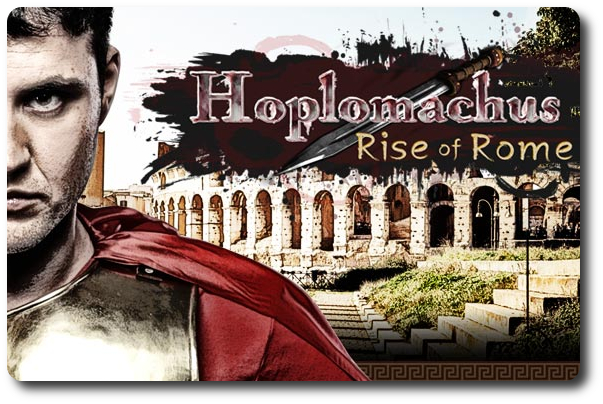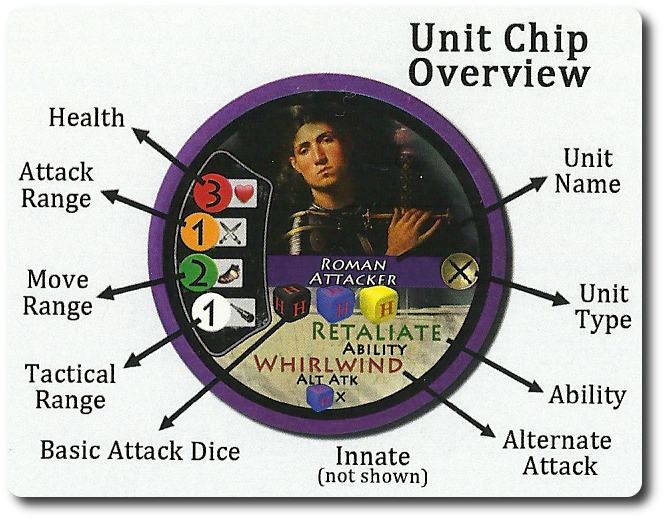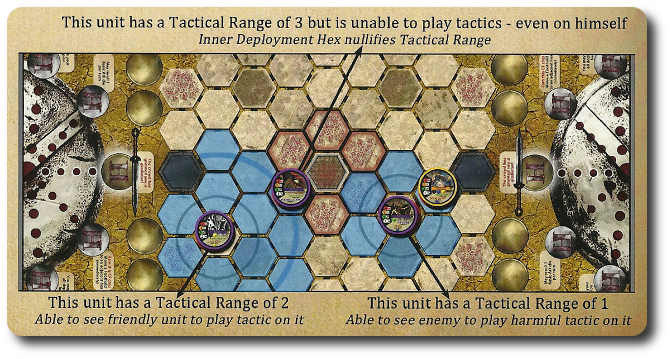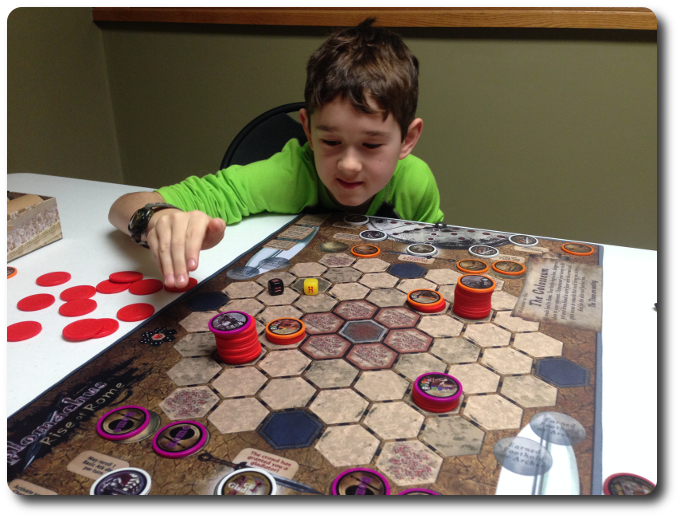
The Basics:
- For ages 8 and up (publisher suggests 12+)
- For 1 to 2 players (solo, competitive, and cooperative)
- Approximately 60 minutes to complete
Geek Skills:
- Active Listening & Communication
- Counting & Math
- Logical & Critical Decision Making
- Reading
- Pattern/Color Matching
- Strategy & Tactics
- Risk vs. Reward
- Visuospatial Skills
- Cooperative & Team Play
- Hand/Resource Management
- Area Control
Learning Curve:
- Child – Easy
- Adult – Easy
Theme & Narrative:
- Enter the arena again and fight with honor!
Endorsements:
- Gamer Geek approved!
- Parent Geek approved!
- Child Geek approved!
Overview
The crowds cheer and chant the for the men who have come to fight and die in the arena. The names of the fallen and those gladiators still fighting are shouted from windows, doorways, and streets with more love than the name of the Emperor. Which, as you can imagine, has the Emperor worried. Concerned that his own reputation is on the line (not to mention his life), the Emperor decrees that Rome and Pompeii will now enter the arena to show the Empire that the greatest warriors are those who are loyal to the Emperor and the Emperor alone.
Hoplomachus: Rise of Rome, designed by Adam Carlson, Josh J. Carlson and published by Chip Theory Games, is comprised of 1 game mat (think mouse pad, but thicker), 7 Reference cards, 3 yellow Attack costume six-sided dice, 2 blue Attack custom six-sided dice, 2 green Attack custom six-sided dice, 2 black Attack custom six-sided dice, 1 standard six-sided die, 2 Crowd Favor tokens, 2 Chip bags, 75 Health chips, 1 Flip chip, 2 City Emblem chips, 1 Rome Champion chip, 10 Rome Gladiator chips, 4 Rome Tactics chips, 1 Pompeii Champion chip, 10 Pompeii Gladiator chips, 4 Pompeii Tactics chips, 6 Titan/Gladiator chips, 4 Shard chips, and 8 Foothold chips. Every component is durable and well made, which is exactly what I have come to expect from Chip Theory Games.
Note: Hoplomachus: Rise of Rome is not an expansion to Hoplomachus: The Lost Cities. It’s a standalone game. However, players familiar with Hoplomachus: The Lost Cities will be able to play Hoplomachus: Rise of Rome right out of the box without issue. The only difference between the two games are subtle rule variations that make Hoplomachus: Rise of Rome feel more streamlined than its older brother. That and the game components, of course. In truth, it feels like a new chapter in a continuing story with clear ties to its origins.
We Salute Those Who Are About to Die
At the core of the game are the chips. The red Health chips are used to keep track of an individual gladiator’s state of health. No Health chips means no life. On the top of each stack of Health chips it the chip that represents the warrior in the pit fighting for glory and their life. There are 2 such chips: Champion and Gladiator, which are collectively referred to as “Unit chips”. The Champion chip is the primary warrior, and like the King in a game of Chess, the removal of a player’s Champion means defeat.
That Tactic chips describe a special tactic that can be taken by the player during the game and is also considered a Unit chip, but it doesn’t represent a warrior. These are very special chips as they allow the player to bend the rules. Not break, mind you. Simply bend. In a game of life and death on the hot sands of the Colosseum floor, the smallest advantages could lead to the greatest of victories.
The Gladiator chips are more than just brutes with swords. They represent archers, tacticians, designated attackers, and well armored defenders. Unlike the Champion chip, losing a Gladiator chip does not cost the player the game. However, it does put them at a disadvantage. When you are in the pit, every drop of blood that hits the sand that isn’t your enemy’s is a set back.
All Champion and Gladiator chips, regardless of the city they represent, use the same layout. The face of the chip that sits on top of the Health chips summarizes everything a player needs to know in order to plan an attack or make ready to defend. The Champion chip has 2 sides to represent when the Champion is active or inactive, but the information is the same.

- Health indicates how many Health chips are placed underneath the Unit chip.
- Attack Range indicates how many hexes away the Unit chip can attack an enemy Unit chip. For example, an Attack Range of “1” indicates that the Unit chip can only attack targets that are adjacent to it.
- Move Range indicates how many hexes the Unit chip can move on their turn. A Unit chip is never forced to move their maximum range or at all. Sometimes it’s best to hold your ground.
- Tactical Range indicates how many hexes away the effects of a Tactical chip can be played. Ever Unit chip has a default Tactical Range of “0”, meaning Tactical chips can be played on the Unit who is using it on their turn.
- Basic Attack Dice identify the number and color of the dice rolled when the Unit attacks. Depending on the color of the Attack die used, the odds of successfully hitting are significantly increased.
- Alternate Attack is an optional action that can be taken by the player if they do not want to use the Unit chip’s Basic Attack. For example, the Unit chip pictured above has an Alternative Attack named “Whirlwind” that allows the player to roll as many blue Attack dice as there are total adjacent defenders. The total damage determined by the die roll is applied to all the adjacent enemy Unit chips! Complete details about each Alternative Attack are listed on the back of the game rule book for easy reference.
- Innate is a special Unit chip characteristic that identifies an ability that is “always on”. Unlike a Unit chip’s Ability that must be activated by the player, an Innate characteristic is triggered when certain conditions exist.
- Ability is a special Unit chip action that can be used once per player turn. For example, the Unit chip pictured above has an Ability named “Retaliate” that automatically deals 1 damage to an attacking adjacent enemy Unit chip if they used their Basic Attack. Like the Alternate Attacks, complete details about each Ability are listed on the back of the game rule book for easy reference.
- Unit Type identifies each chip as either a Champion, City Gladiator, Archer, Attacker, Defender, or Tactician.
Combat Begins
Note: Hoplomachus: Rise of Rome can be played several different ways. The standard player versus player game is summarized here. Additional game modes are summarized below. There are also many different ways to complete your turn. Hoplomachus: Rise of Rome is a very tactical game and player’s strategy is defined in part by the Unit chips they are using. As such, I will not cover every aspect of the game play here.
A player versus player game starts with both Champion chips in an inactive state. Players must activate their Champion to use them via Crowd Favor. Until then they are sitting ducks, albeit well armored and armed ones. When the game begins, each player will draw and keep hidden 4 chips from their Chip bag. These chips will be a mix of different Unit types that the player can use. Consider them as the player’s starting hand. These chips are kept face-down in front of the player on the game mat. During the game, if a player should ever have 4 unplayable Tactic chips, they can reveal them to their component to draw 4 new chips.
Game play is very straight forward, although the choices the player will need to make during their turn are not so simple. A player’s turn is summarized here and consists of phases.
Phase 1: Deployment
The player has the option of playing 1 Gladiator and Tactic chip, 1 Gladiator chip, 1 Tactic chip, or no chips at all. These chips can be from the player’s city or any earned from Crowd Favor (see Phase 3). Deployed Gladiator chips can be played on any open deployment space. Each player has 2 special deployment spaces reserved just for their Unit chips and a shared central deployment area that consists of 7 hexes, wherein the center most hex actually reduces the health of the deployed Unit chip. Deployed Unit chips cannot take any other action during this turn, but they might have an Ability or Innate characteristic that allows them to interact with other Unit chips. When deploying, make certain you place the correct number of Health chips under the Unit chip.

When deploying a Tactic chip, it must be placed on a friendly Unit chip that is within the Tactical Range of another friendly Unit chip. Once deployed, it’s immediately available.

Phase 2: Movement
The player can now optionally move 1, some, all, or none of their Unit chips. There are only 2 rules to movement.
- A Unit cannot move to or through any hex occupied by another Unit (unless they have an Innate characteristic or Ability that says otherwise)
- A Unit cannot exceed its total Move Range, nor can is “bank” any unused movement for later
Phase 3: Attacking and Crowd Favor
The player can now optionally attack any enemy Unit chip that is within range. Each Unit chip can attack once and it’s up to the player to determine if the Unit chip’s Basic Attack or Alternate Attack should be used. To make combat faster, Line of Sight (LoS) is not used when attempting to hit a target that is further than 1 hex away.
To make an attack, the player identifies which Unit chip they are using and which attack type (Basic or Alternate). They they identify the target enemy Unit chip and collect the correct number of color of Attack dice for the attack type being used. The dice are then rolled. Each “H” indicates 1 hit and reduces the target enemy Unit chip’s health by 1 (tracked by removing a Health chip), but not before the target enemy Unit chip uses any defensive ability to counter the attack.
For every Health chip that is removed from an enemy, the player can move their Crowd Favor token 1 spot on the Crowd Favor track. The Crowd Favor token can move in any direction, but it can never move off the paths. Players should not take the movement of their Crowd Favor token lightly. Each path from the starting central position leads to an Arena ability favor that can be unlocked. When the Crowd Favor token reaches the favor, it’s available to the player, but the chip next to it goes to the opponent. The Crowd Favor token is then reset and the player must now work to obtain a new reward by pleasing the crowd.
Arena abilities include:
- Unlocking and activating your champion! Finally! Now get out there and fight!
- Re-roll 1 die that is part of a Basic Attack once per turn.
- Unlock a new gladiator.
- Establish a foothold.
- More hexes to deploy in.
Phase 4: Draw
If the player has not yet drawn any chips, they draw them now, bringing their hand to 4 chips. This concludes the player’s turn. The player’s opponent now takes their turn starting with step 1 noted above.
Victory!
The game continues until one player loses their Champion chip. The player who took down their opponent’s Champion is declared the victor!
Enter the Titans
The Titans are the “big baddies” in the game. They belong to the arena and they plan to remain the arena’s champions. Using them allows players to enjoy a solitary beat down or a cooperative match against a very difficult foe. The one constant between the two different types of game modes are the formidable Titans. These are not your standard warriors in the pit. Each Titan is a powerhouse, a champion’s champion, if you will with supernatural powers at their command. Each game mode is summarized here and has a different game set up than the player versus player game mode summarized above. For the most part, the rules are the same, except where noted here.
There are 4 Titans to select from. Each is unique and will provide different levels of difficulty.
- Menoetius is the weakest of the Titans, but is still a formidable foe. He has an Attack Range of 3 and is immune to all Basic Attacks!
- Theia might not be able to be the strongest physical attacker, but her mind is sharper than any weapon ever created. It’s rumored that she can bend time and space with just a thought!
- Oceanus is a mighty warrior, but his true strength comes from commanding other Gladiators. He will call in new forces when you least expect it, including calling the very elements to aid him.
- Cronus only focuses on one thing in the arena and that is smashing all in his path. He combines his rage and might to toss nearby Gladiators across the arena like rag dolls. One hit from this foe is like being smashed by a mountain.
The movement and attack of a Titan is determined by the Titan Reference card and the results of rolling dice. As such, the Titan is a chaotic opponent with random attacks, but not so random as to be impossible to defeat.
The only other aspect of the Titans that is worth mentioning are Titan Shards. These must be collected by the player by attacking areas on the game mat. The more Shards the player collects, the less fearsome the Titan becomes. The player is always welcome to attempt to fight the Titan and their summoned warriors directly, but they will fail. Collecting the Titan Shards is the fist step in working towards victory.
One Player, One Titan
The player selects a city and takes the corresponding Unit chips to represent their forces. The player then chooses which Titan to battle, setting up the game mat per the Titan Reference card instructions.
The player will take their turn as normal. The Titan takes their turn after the player, but what they do is determined by rolling dice and looking up the results that are noted on the Titan Reference card. The Titan Reference card will also list the order in which the Titan and his minions take their actions. After the Titan and all enemy Unit chips take their actions, the Titan’s turn is over.
The game continues with the player taking their turn and then resolving the Titan’s actions. If the player’s Champion falls, the Titan wins. If the Titan falls, the player wins.
Cooperative Titan Beat Down
This game mode allows players to work together as they face 2 Titans. Luckily, the Titans come one at a time, allowing the players to focus on surviving only 1 Titan before attempting to tackle the next one. Players will both select a city and both Champions must survive if the players want to win the game. All Crowd Favor is shared and both cities are considered “friendly”, meaning units of opposing cities have put their differences aside in order to survive. Smart move.
Game Variants
The Found Cities
The Champion, Gladiator, and Tactic chips in Hoplomachus: Rise of Rome and Hoplomachus: The Lost Cities are interchangeable, as are the arenas (game mats). Players who own both games can mix and match, creating many different battles in the two arenas. Both or individual games can be further customized using the Hoplomachus add-ons.
Cities Versus Cities
By combining Hoplomachus: The Lost Cities and Hoplomachus: Rise of Rome, players can set up a game that allows 4 players. Players are organized into teams of 2 and each team takes on a city. Players then work together to defeat their opponents.
To learn more about Hoplomachus: Rise of Rome, visit the publisher’s website.
Final Word
Note: We played with Hoplomachus: Rise of Rome with players who were and were not familiar with Hoplomachus: The Lost Cities. The goal was to have both groups equally and fairly represented during our review.
The Child Geeks who were already familiar with Hoplomachus: The Lost Cities dove right into the game without any issues. For them, the only new aspect of the game to familiarize themselves with was the new Crowd Favor, game mat, and Unit chips. All of which can be explained in less than 10 minutes. For the Child Geeks brand new to the game, the most difficult part to remember was what each Unit chip did. Helpful older Child Geeks and Parent Geeks were on hand to provide help when and where needed. In all cases, the Child Geeks demonstrated excellent understanding and usage of tactical movement, but the level of strategy used depended on the individual Child Geek’s playing style. Some enjoyed rushing in and swinging swords like mad while others preferred to pick off their enemies from a distance. In both cases, the game accommodated the different approaches brilliantly. According to one Child Geek, “What I’ve always liked about this game is that you can do whatever you want with your gladiators.” Very true. The rules for movement and combat are minimal, allowing players to work within the loose framework as they choose. Another Child Geek said, “I like how the gladiators get smaller as they get weaker.” The Health chips are a great way to keep track of individual Unit health and there is nothing more intimidating than being lost in the shadow of a towering Unit chip on a pillar of red. When all the games were over, the Child Geeks voted to approve Hoplomachus: Rise of Rome, preferring the player versus player game mode to any other provided.

My son attacks my Champion! All I can do is watch him remove the Health chips with a smile.
The Parent Geeks were not opposed to the player versus player game mode, but they prefered the cooperative game play. According to one Parent Geek, “I always like it when I can play with my kids instead of against them.” Hoplomachus: Rise of Rome allows players to do just that by facing the Titans. The Parent Geeks enjoyed many of the same game play aspects as the Child Geeks, but appreciated the tactical and strategic play on a deeper level. According to one Parent Geek, “The game gives you a lot to think about in a way that is very easy to mentally juggle. I never feel overwhelmed or underwhelmed. It’s like Baby Bear’s porridge: it’s just right.” The non-gamers didn’t like the game as much, finding it to heavy and demanding at times, but they never complained when playing it. When all the games were over and the arena was cleared, the Parent Geeks voted to approve Hoplomachus: Rise of Rome.
The Gamer Geeks enjoyed the simplistic approach the game takes to combat and the visual style in which it’s presented. They liked the new Crowd Favor track that gives players the ability to choose which favor they need the most. What they didn’t care for was how the player’s chip hand was handled. According to one Gamer Geek, “Being able to hold 4 chips at a time is fine, but my individual slots to hold chips in my hand are being taken by chips I don’t want. I need gladiators, not tactics!” This issue was also mentioned by groups who needed tactics, not gladiators. All the Gamer Geeks agreed it wasn’t a problem so much as an inherent flaw in the system that could be found in a lot of card games, too. As far as combat, strategy, and tactics go, the Gamer Geeks found Hoplomachus: Rise of Rome to be light. Almost casual, in some respects, but not without merit. As one Gamer Geek put it, “The rules are fairly simple and combat is streamlined enough to make it feel at times like everything is obvious, but there is enough strategy and tactics to make each battle worth playing.” Which is Gamer Geek code for “fun to play”. The Gamer Geeks tried the different game modes and found that player versus player was the best, followed by 2-player cooperative against the Titans. When all their games were over, they approved Hoplomachus: Rise of Rome, finding it to be an enjoyable gladiator game with casual game play, strategic decisions, and tactical actions.
Hoplomachus: Rise of Rome is easy to teach. It took our new players longer to grasp how the game was played, but at no time did they say it was difficult. The difficulty is not in learning how to play the game, but how to beat the game or your opponent. Depending on your opponent, that can be a very easy education session or a painful one. We made it a point to always pair our players against opponents who had similar skill levels and experiences. This created a level playing field and a more enjoyable game.
I’m still a fan of the game, but now I’m not sure which of the two Hoplomachus games I like more. Both provide excellent game play, fantastic depth, involved strategies, and delightful tactics. The subtle differences between the two get lost easily when you are playing, making both games blend together. For certain, Hoplomachus: Rise of Rome builds off its predecessor, but the game stands on its own. It would be incorrect to suggest that Hoplomachus: Rise of Rome is “more of the same”. One of our players suggested that the differences between the two games was the same differences between the American Football League and the National Football League. Another player said the differences were similar to Marvel Comics and DC Comics. In short, the differences are in the details, but there are many common qualities shared between both games.
In which case, both are good. Combining them is like putting extra frosting on an already well frosted cake. That might be too much for some or just what is needed for others. Regardless, Hoplomachus: Rise of Rome stands on its own and was a delight. While it brought little to the gaming table that was new, its presentation, quality, and game play made everyone happy. If you are in the mood for a game full of strategic and tactical gladiatorial combat, do take a look into Hoplomachus: Rise of Rome. Even if you lose in the Colosseum, you’ll still leave feeling like a winner.
This game was given to Father Geek as a review copy. Father Geek was not paid, bribed, wined, dined, or threatened in vain hopes of influencing this review. Such is the statuesque and legendary integrity of Father Geek.



